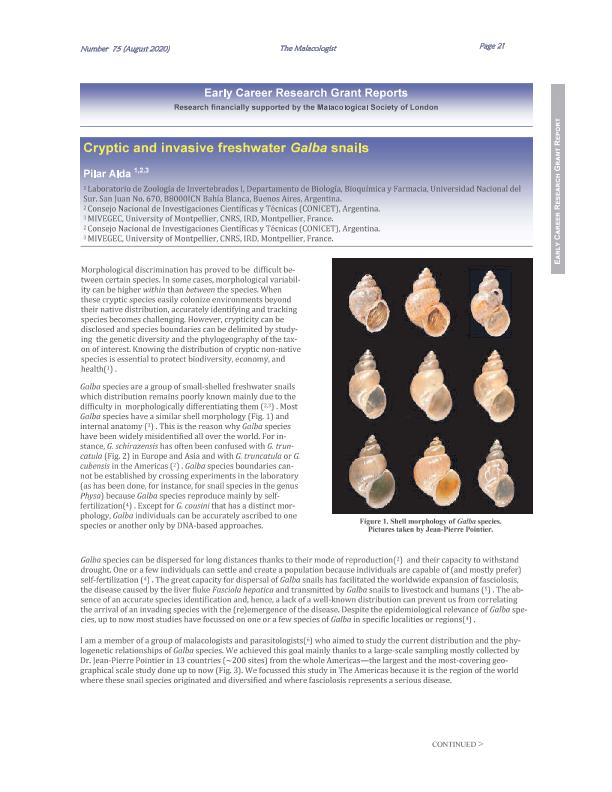Artículo
Cryptic and invasive freshwater Galba snails
Fecha de publicación:
19/08/2020
Editorial:
The Malacological Society of London
Revista:
The Malacologist
ISSN:
1759-1406
Idioma:
Inglés
Tipo de recurso:
Artículo publicado
Clasificación temática:
Resumen
Thanks to the Early Career Research Grant and other grants, we developed an integrative approach combining morphological observations with molecular markers (microsatellites and DNA sequences for four genes) to analyze Galba samples taken from across The Americas 6. Our American database was augmented with data retrieved from GenBank (including Old World samples; Fig. 3) and analyzed using species delimitation methods and Bayesian phylogenetic reconstruction. Our analysis suggest that the genus Galba evolved ca. 22 myr ago and today comprises six clusters of populations. We recommend redefining species boundaries such that three of these clusters are understood as one species each, and that the other three clusters correspond to two highly diverse species or species complexes 6. We also conclude that crypsis in the genus Galba may best be explained by shared morphological stasis. Galba populations live in temporary habitats and are more amphibious than other freshwater snails, which may mitigate both predation and interspecific competition. Adaptation to such habitats may impose strong stabilizing selection for a shell morphology able to resist desiccation and concomitant morphological stasis 6. We emphasize that cryptic Galba species must be accurately identified with molecular markers since these species demonstrate different patterns of invasiveness and susceptibility, host-parasite compatibility, and immunological resistance to Fasciola hepatica.
Palabras clave:
CRYPTIC GALBA SPECIES
,
MOLECULAR MARKERS
,
INVASIVE SNAILS
Archivos asociados
Licencia
Identificadores
Colecciones
Articulos(CCT - BAHIA BLANCA)
Articulos de CTRO.CIENTIFICO TECNOL.CONICET - BAHIA BLANCA
Articulos de CTRO.CIENTIFICO TECNOL.CONICET - BAHIA BLANCA
Citación
Alda, Maria del Pilar; Cryptic and invasive freshwater Galba snails; The Malacological Society of London; The Malacologist; 75; 19-8-2020; 21-22
Compartir




